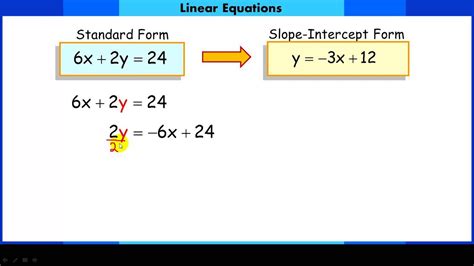Understanding Standard Form and Y-Intercept Form

Converting standard form to y-intercept form is an essential skill for any student of algebra. The standard form of a linear equation is Ax + By = C, where A, B, and C are constants, and x and y are variables. On the other hand, the y-intercept form of a linear equation is y = mx + b, where m is the slope of the line and b is the y-intercept. In this article, we will explore the process of converting standard form to y-intercept form and provide examples and exercises to help you master this skill.
The Importance of Converting Standard Form to Y-Intercept Form
Converting standard form to y-intercept form is crucial in various algebraic applications, such as graphing linear equations, finding the slope and y-intercept of a line, and solving systems of linear equations. By converting standard form to y-intercept form, you can easily identify the slope and y-intercept of a line, which are essential components of linear equations.
The Steps to Convert Standard Form to Y-Intercept Form

Converting standard form to y-intercept form involves a simple process of rearranging the terms in the standard form equation. Here are the steps:
- Write the standard form equation: Start with the standard form equation Ax + By = C.
- Subtract Ax from both sides: Subtract Ax from both sides of the equation to isolate the y-term. This will give you By = -Ax + C.
- Divide both sides by B: Divide both sides of the equation by B to solve for y. This will give you y = (-A/B)x + C/B.
- Simplify the equation: Simplify the equation by combining the constants and rewriting the equation in y-intercept form, y = mx + b.
Example 1: Converting Standard Form to Y-Intercept Form
Suppose we have the standard form equation 2x + 3y = 6. To convert this equation to y-intercept form, we follow the steps:
- Write the standard form equation: 2x + 3y = 6.
- Subtract 2x from both sides: 3y = -2x + 6.
- Divide both sides by 3: y = (-2/3)x + 2.
- Simplify the equation: y = (-2/3)x + 2.
The resulting equation is in y-intercept form, where m = -2/3 and b = 2.
Practical Applications of Converting Standard Form to Y-Intercept Form

Converting standard form to y-intercept form has numerous practical applications in algebra and beyond. Some of these applications include:
- Graphing linear equations: By converting standard form to y-intercept form, you can easily graph linear equations by identifying the slope and y-intercept of the line.
- Finding the slope and y-intercept: Converting standard form to y-intercept form allows you to identify the slope and y-intercept of a line, which are essential components of linear equations.
- Solving systems of linear equations: Converting standard form to y-intercept form can help you solve systems of linear equations by providing a clear and concise representation of the equations.
Exercises and Examples
Here are some exercises and examples to help you practice converting standard form to y-intercept form:
- Convert the standard form equation x + 2y = 4 to y-intercept form.
- Convert the standard form equation 3x - 2y = 5 to y-intercept form.
- Convert the standard form equation 2x + 5y = 3 to y-intercept form.
Solutions:
- y = (-1/2)x + 2.
- y = (3/2)x - 5/2.
- y = (-2/5)x + 3/5.
Conclusion
Converting standard form to y-intercept form is a crucial skill in algebra that has numerous practical applications. By following the simple steps outlined in this article, you can easily convert standard form to y-intercept form and master this essential skill. Remember to practice regularly and apply your knowledge to various algebraic applications.
What is the standard form of a linear equation?
+The standard form of a linear equation is Ax + By = C, where A, B, and C are constants, and x and y are variables.
What is the y-intercept form of a linear equation?
+The y-intercept form of a linear equation is y = mx + b, where m is the slope of the line and b is the y-intercept.
Why is it important to convert standard form to y-intercept form?
+Converting standard form to y-intercept form is crucial in various algebraic applications, such as graphing linear equations, finding the slope and y-intercept of a line, and solving systems of linear equations.
